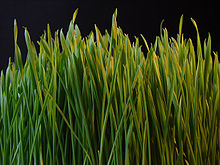Ingca
Ingca luhlobo lwesityalo. Uhlobo lwengca oluxgaphakileyo lusetyenziswa ukugquma ibala enkundleni



ingca,[1] okanye iintlobo zengca, zinembewu elukhozo olunye kuphela, singathi ngokwesiqhelo azizityalo ezinohlaza zinamagqabi ajonge phezulu ukusuka apho acela khona kwisiseko sawo. Iquka "uqobo lwengca", kusapho lwePoaceae (nekwaziwa ngegama elithi Gramineae), nelithi sedges (iCyperaceae) kunye nerushes (iJuncaceae).
Ingca yokwenyani iquka iicereal, ibamboo kunye nengca yeenkundla (iturf) kunye nengca yomhlaba. iiSedges ziquka izityalo ezininzi zasendle ziquka uhlazakunye nezityalo zengca yomhlaba, nezinye ezityaliweyo njengechestnut yamanzi (iEleocharis dulcis) kunye nepapyrus sedge (iCyperus papyrus). Ingca isetyenziswa kwezi zinto zilandelayo ukutya (okunje ngeenkozo, ezityiwa ziluhlaza, amasebe asematsha okanye iziqu zezityalo esifumaneka ngaphantsi komhlaba), isiselo(ibhiye, iinyembezi zikaVitoliya), amadlelo emfuyo, ukufulelea indlu, iphepha, ukubasa, ukunxiba, ukoleka, ukwakha, ingca eyenzelwe ibala lemidlalo, isingxobo uhlobo losebenza ngesiziba nezinye izinto ezininzi.
Ingca eninzi imfutshane, kodwa enye ingca efana nebamboo ingakhula ibhakuzele ibende kakhulu. Izityalo eziphuma from the grass family can grow in many places, even if they are very cold or very dry. Several other plants that look similar but are not members of the grass family are also sometimes called grass; these include rushes, reeds, papyrus, and water chestnut.
Grasses are an important food for many animals, like deer, buffalo, cattle, mice, grasshoppers, caterpillars, and many other grazers. Unlike other plants, grasses grow from the bottom, so when animals eat grass they usually don't destroy the part that grows.[2] Without grass, dirt can wash away into rivers. This is called erosion.
Isuka phi ingca?
tshintshaGraminoids include some of the most versatile plant life-forms. They became widespread toward the end of the Cretaceous. Fossilized dinosaur dung (coprolites) have been found containing grass phytoliths (silica stones inside grass leaves).[3] Grasses have adapted to conditions in lush rain forests, dry deserts, cold mountains and even intertidal habitats, and are now the most widespread plant type. Grass is a valuable source of food and energy for many animals.[4]
Ingca kunye nabantu
tshintshaLawn grass is often planted on sports fields and in the area around a building. Sometimes chemicals and water is used to help lawns to grow.
People have used grasses for a long time. People eat parts of grasses. Corn, wheat, barley, oats, rice and millet are cereals, common grains whose seeds are used for food and to make alcohol such as beer.
Sugar comes from sugar cane, which is also a plant in the grass family. People have grown grasses as food for farm animals for about 10,000 years. Grasses have also been used to make paper for more than 4000 years. People use bamboo to build houses, fences, furniture and other things. Grass plants can also be used as fuel, to cover roofs, and to weave baskets.
Ulwimi
tshintshaIn English, the word "grass" appears in several phrases. For example:
- "The grass is always greener on the other side" means "people are never happy with what they have and want something else."
- "Don't let the grass grow under your feet" means "Do something".
- "A snake in the grass" is about a person that will be not be honest and will trick others.
- Grass is sometimes used as a slang term for cannabis (also called pot, weed, or marijuana).
Kwezinye iiwebsite
tshintshaIzalathiso
tshintsha- ↑ Chapman G.P. & Peat W.E. 1992. An introduction to the grasses. Oxford: CAB Internat.
- ↑ Cheplick G.P. 1998. Population biology of grasses. Cambridge University Press.
- ↑ Piperno, Doris E. & Sues, Hans-Dieter 2005. Dinosaurs dined on grass. Science. 310 (5751), pp. 1126 - 1128.
- ↑ Soderstrom T.R. et al (eds) 1987. Grass systematics and evolution. Smithsonian Institution Press, Washington, D.C.